
CBSE Worksheet for Chapter - 9 Line and Angles Class 8
Worksheets For class 8
Find CBSE Worksheet for chapter-9 Line and Angles class 8
CLASS-8
BOARD: CBSE
Mathematic Worksheet - 9
TOPIC: Line and Angles
For other
CBSE Worksheet for class 8 Mathematic
check out main page of Physics Wallah.
SUMMARY:
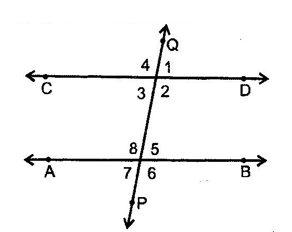
1. Transversal:
A line which intersects two or more given parallel lines at distinct points is called a transversal of the given lines.
2. Corresponding angles:
∠1 & ∠ 5, ∠ 4 & ∠ 8, ∠ 2 & ∠ 6, ∠ 3 & ∠ 7 are pairs of corresponding angles.
3. Alternate interior angles:
∠ 3 & ∠ 5, ∠ 2 & ∠ 8 are the pairs of alternate interior angles.
4. Consecutive interior angles:
∠ 2 & ∠ 5, ∠ 3 & ∠ 8, are pairs of consecutive interior angles.
5. Vertically opposite angles:
in figure, ∠ 1 = ∠ 3, ∠ 2 = ∠ 4, ∠ 5 = ∠ 7 & ∠ 6 = ∠ 8.
OBJECTIVE:
1. Two supplementary angles are in ratio 4 : 5, then the angles are:
(A) 80°, 100°
(B) 70°, 110°
(C) 80°, 120°
(D) None
2. If an angle differs from its complement by 10°, find the larger angle.
(A) 45°
(B) 50°
(C) 95°
(D) 60°
3. In the given figure, OP and OQ bisect ∠ BOC and ∠
AOC respectively, then ∠
POQ is.
(A) 90°
(B) 45°
(C) 135°
(D) 180°
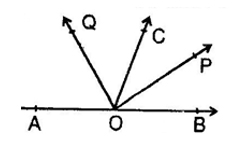
4. In the given fig if l II m, n II p and ∠1 = 85° then ∠ 2 is
(A) 95°
(B) 110°
(C) 135°
(D) 85°
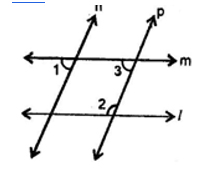
5. An larger angle is 14° more than its complementary angle then angle is:
(A) 38°
(B) 52°
(C) 50°
(D) none of these
6. X lies in interior of ∠BAC. If ∠BAC = 70° and ∠BAX = 42° then ∠XAC = ?
(A) 28°
(B) 29°
(C) 27°
(D) 30°
7. If the supplement of an angle is three times its complement, then angle is:
(A) 40°
(B) 35°
(C) 50°
(D) 45°
8. Two angles whose measures are a & b are such that 2a – 3b = 60°, if they form a linear pair then find 4a/5b.
(A) 0
(B) 8/5
(C) 1/2
(D) 2/3
9. The supplement of an angle is one third of itself. Then the angle is:
(A) 135°
(B) 45°
(C) 140°
(D) None
10. In given figure, if ∠BOC = 7x + 20° and ∠COA = 3x, then the value of x for which AOB becomes a straight line.
(A) 15°
(B) 12°
(C) 16°
(D) None
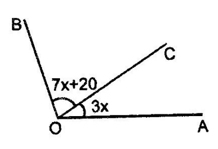
11. In given figure if AB II DF, AD II FG ∠BAC = 65°, ∠ACB=55
o
∠FGH is:
(A) 120°
(B) 125°
(C) 115°
(D) 140°
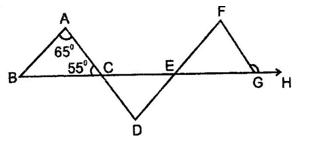
12. In given figure, AB II ED and ∠ABC = 30°, ∠EDC = 70° then x is:
(A) 240°
(B) 125°
(C) 260°
(D) None
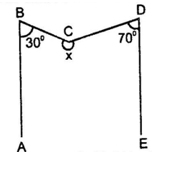
13. In the given figure, if EC II AB, ∠ECD = 70° and ∠BDO = 20°, then ∠OBD is-
(A) 20°
(B) 50°
(C) 60°
(D) 70°
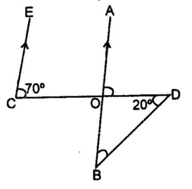
14. Given AB II CD, x° =
(A) 20°
(B) 70°
(C) 110°
(D) 35°
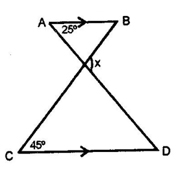
15. As shown in the figure
 . If point P is between these two lines such that m∠ABP = 50° and m∠CDP = 70° then find ∠BPD.
. If point P is between these two lines such that m∠ABP = 50° and m∠CDP = 70° then find ∠BPD.
(A) 120°
(B) 70°
(C) 110°
(D) 50°
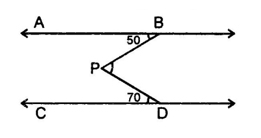
16. The measure of that angle which is four times its supplement is:
(A) 36
(B) 144°
(C) 155°
(D) 180°
Solutions: to worksheet-9 Topic- Line and Angles
Objective:
1) A
2) B
3) A
4) A
5) B
6) A
7) D
8) B
9) A
10) C
11) B
12) C
13) B
14) B
15) A
16) B









